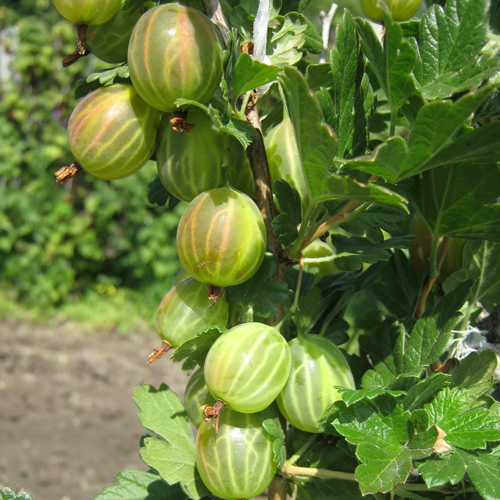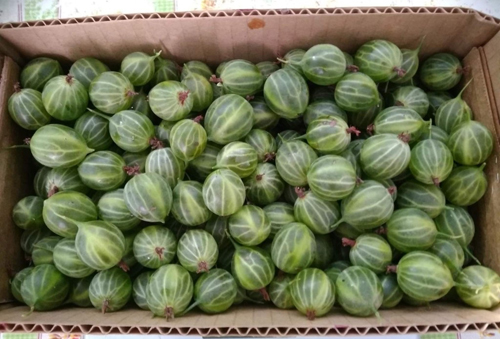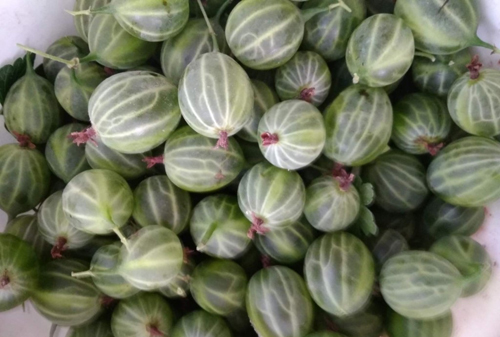Gooseberry variety Malachite
In Russia, gooseberries have been known for several centuries. But at the beginning of the 20th century, powdery mildew drastically reduced the number of plantings. The main task of the breeders was to develop new varieties of this culture that are resistant to the fungus. In 1949, scientists from the Central Research Institute of Northern Fruit and Berry Economy (now part of the IV Michurin Federal Scientific Center) applied for the registration of a new gooseberry variety called Malachite. Almost 10 years later, in 1959, it was entered into the State Register of Breeding Achievements of the Russian Federation. The author is K.D. Sergeeva. Parental forms are Date and Black Negus. The culture shows its maximum potential in regions with moderately hot summers and long winters - Central, Central Black Earth, Volgo-Vyatka, North, North-West, Middle Volga, Nizhnevolzhsky, Ural and Far East.

Description
The bush is vigorous, with a high shoot-forming ability, rather spreading and dense. Height is about 1.3 - 1.5 meters. At the same time, the plant looks compact and neat. The shoots of the variety are curved, of moderate thickness, not pubescent, covered with a light green bark, which sometimes shows a weak anthocyanin coloration. Long branches intertwine and form a dense bush. Gooseberry shoots along the entire length, except for the top, are moderately covered with thorns. Malachite's thorns are dark-colored, small, of medium thickness, straight, mostly single, less often 2-3-separate. Pointed perpendicular to the shoot or up. The lower internodes are covered with spines. Buds are small, not pubescent, dark brown, ovoid in shape, pointed apex, grow deviating from the shoot.

Large, grayish-green leaves are pubescent on both sides. The surface is matte, smooth. The leaf blade of the variety is concave, the base is straight, sometimes with a shallow notch, the edge is dotted with blunt, not bent, medium-sized teeth. The sheet has five lobes with deep and narrow cutouts. The middle lobe with straight lateral edges rises above the rest. The lateral lobes are pointed, the tops are directed upward, the angle between the veins of the lateral lobes is sharp. The angle of attachment of the petiole and the base of the plate is straight. The petiole of Malachite is long, not very thick, located at an angle of 45 ° to the shoot, covered with sparse glandular pubescence. The small flowers and sepals of the gooseberry are brightly colored. There are 1 or 2 flowers in a brush. Sepals are free, bent down. The ovary is naked.

Fruits are round, slightly elongated, sometimes slightly pear-shaped. The berries cannot be called one-dimensional, the average weight is 4 - 6 grams, but often larger specimens ripen - up to 8 grams. Unripe fruits are intense green or malachite, when ripe they brighten, become a pleasant light green color, but do not turn yellow. A slight tan may appear on the sunny side. The surface is not pubescent, slightly waxed. There are a lot of seeds. The skin is thin, transparent, smooth, with well-visible, dense veins. The veins are strongly branched and are lighter in color than the main color. The cup of Malachite is not always full, half-open, or closed. The peduncle of the variety is thin, moderately long, dark green. Gooseberry taste assessment is satisfactory - 3.7 points. Despite the delicate and juicy pulp of sweet and sour taste, the skin is strongly acidic, leaving a not very pleasant aftertaste. Berries are very useful, they contain many macro- and microelements. 100 grams of the raw product contains: titratable acids - 2.0%, the amount of sugars - 8.6%, ascorbic acid - 23.0 - 40.8 mg.

Characteristics
- During the fruiting period, Malachite can enter as early as 2 - 3 years after planting;
- in terms of ripening, the gooseberry is mid-season;
- the duration of a fruitful life is 15 years;
- The winter hardiness of the variety is very high, it can withstand frosts down to -30 ° C. Does not suffer from sudden changes in winter temperatures. The flowers do not freeze slightly, since the flowering is not early;
- the plant is characterized by excellent drought resistance;
- the variety has good immunity, it is highly resistant to American powdery mildew. But it can suffer from septoria and rust;
- pests (mainly firefighters and sawflies) bypass the culture. But if the nearby bushes are massively infected with pests, then Malachite can also suffer;
- the yield of the variety is stable, annual, but average - 3.8 - 4.0 kg per bush or 12.6 t / ha;
- the thin skin of the gooseberry fruit can burst, especially often when the soil is waterlogged or during periods of heavy rain;
- transportation possibilities are not bad, but it is not worth transporting overripe berries. At room temperature, the crop can be stored for about 5 days;
- berries have a universal purpose of use, but still, to a greater extent, the variety can be considered technical. The fruits are suitable for processing into jam, freezing. But in the jam, the integrity of the skin cannot be preserved, and the compote will turn out with sediment.
Planting and leaving
It is best to plant gooseberries in the fall, after the bulk of the foliage has fallen, and about a month remains before persistent cold weather. Two year old seedlings are best suited for planting. Considering the fact that Malachite can grow strongly, the bushes need to be planted at a sufficient distance from each other - 1 meter between bushes in a row and 2 meters between rows. Every year in the fall, pruning is carried out, removing the fruiting shoots older than 5 - 6 years. In the spring, sanitary pruning is carried out, if necessary. The plant is undemanding to soils, but loams are best suited. A sunny and dry place will have a positive effect on the yield and quality of the berries. Wetlands with acidic soils are not suitable. The variety is very responsive to feeding.
Malachite is time-tested and takes its rightful place among fashionable novelties. By the disadvantages, many include taste. But there is no dispute about tastes, as they say, sourness will be quite appropriate in the preparation of piquant sauces. Disadvantages in the form of prickly shoots and the need for annual pruning can only be stopped by novice gardeners. An experienced gardener first of all pays attention to the winter hardiness and drought resistance of gooseberries, powdery mildew resistance and annual fruiting.









One of the best varieties with green berries in my opinion. Gave the first fruits for 3 years - the berries are large, dense, remain bright and ripe. Ideal for jam - there is enough acid for gelling, freezing well. Calmly tolerates partial shade from garden trees - I grow next to columnar apple trees, saving space. Simultaneously with the garden, I also process gooseberries - nothing extra is required. The disadvantages include a strong interlacing of shoots - regular thinning of branches growing inside the bush is required.